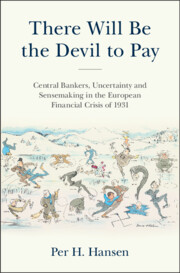 There Will Be the Devil to Pay
There Will Be the Devil to Pay Book contents
- There Will Be the Devil to Pay
- Studies in Macroeconomic History
- There Will Be the Devil to Pay
- Copyright page
- Contents
- Frontispiece
- 1 Introduction
- 2 Central Bankers and Their World
- 3 Preparing for Crisis (May 11–May 19)
- 4 Foreign Creditors (May 16–May 25)
- 5 Moratorium or Guarantee? (May 25–May 27)
- 6 Guarantee at Last? (May 26–June 1)
- 7 Releasing the BIS Credit (May 29–June 5)
- 8 Surrounded with Trouble (June 5–June 10)
- 9 Where and How to Place? (June 8–June 13)
- 10 A World Political Problem (June 11–June 16)
- 11 Francis Rodd Makes Sense – and a Plot (June 9–June 20)
- 12 To Act Now If We Are to Act at All (June 16–June 27)
- 13 Germany Will Collapse (June 19–July 10)
- 14 Anxiety within Germany at Climax (July 11–July 23)
- 15 Going Off the Gold Standard? (July 14–August 21)
- 16 We Must Not Fool Ourselves Now (August 21–September 17)
- 17 As for the Future of England (September 16–October 23)
- The End (2024)
- Timeline
- Actors in the 1931 Financial Crisis Archives
- Acknowledgements
- Archives
- Notes
- Bibliography
- Index
- References
Bibliography
Published online by Cambridge University Press: 21 December 2024
- There Will Be the Devil to Pay
- Studies in Macroeconomic History
- There Will Be the Devil to Pay
- Copyright page
- Contents
- Frontispiece
- 1 Introduction
- 2 Central Bankers and Their World
- 3 Preparing for Crisis (May 11–May 19)
- 4 Foreign Creditors (May 16–May 25)
- 5 Moratorium or Guarantee? (May 25–May 27)
- 6 Guarantee at Last? (May 26–June 1)
- 7 Releasing the BIS Credit (May 29–June 5)
- 8 Surrounded with Trouble (June 5–June 10)
- 9 Where and How to Place? (June 8–June 13)
- 10 A World Political Problem (June 11–June 16)
- 11 Francis Rodd Makes Sense – and a Plot (June 9–June 20)
- 12 To Act Now If We Are to Act at All (June 16–June 27)
- 13 Germany Will Collapse (June 19–July 10)
- 14 Anxiety within Germany at Climax (July 11–July 23)
- 15 Going Off the Gold Standard? (July 14–August 21)
- 16 We Must Not Fool Ourselves Now (August 21–September 17)
- 17 As for the Future of England (September 16–October 23)
- The End (2024)
- Timeline
- Actors in the 1931 Financial Crisis Archives
- Acknowledgements
- Archives
- Notes
- Bibliography
- Index
- References
- Type
- Chapter
- Information
- There Will Be the Devil to PayCentral Bankers, Uncertainty and Sensemaking in the European Financial Crisis of 1931, pp. 459 - 476Publisher: Cambridge University PressPrint publication year: 2025
